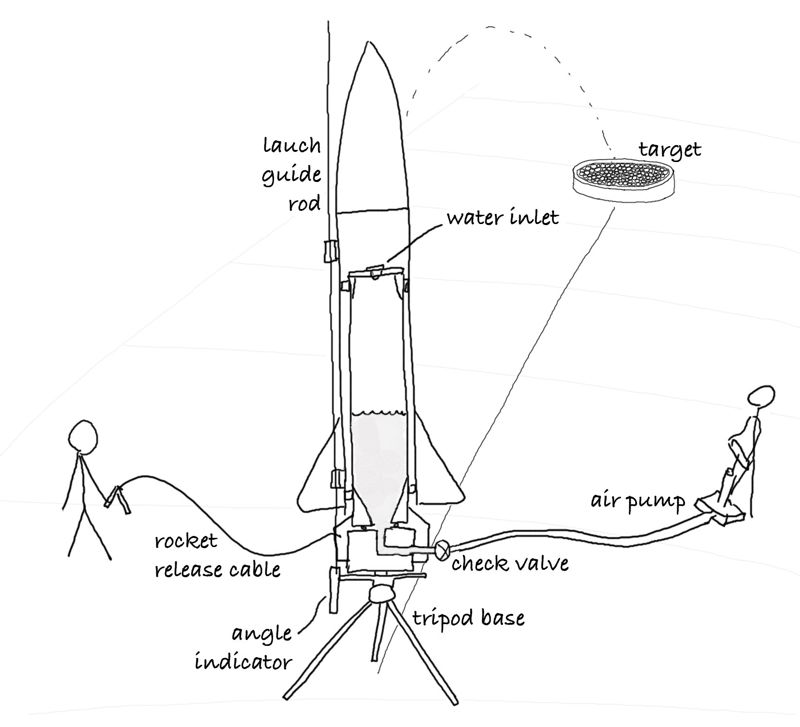MEAM.Design - MEAM 247 - P1: Launch

Overview
We've got a custom-built aluminum and carbon fiber rocket motor filled with water and compressed air. There is a target located a certain distance away along flat ground. You do the math.
Schedule
| Jan 25 | Project Begins | |
| Feb 1 | Thrust Challenge Ends | |
| Feb 10 | Team formation | |
| Feb 12 (modified) | Phase 1 report | |
| Mar 1 (modified) | Phase 2 report | |
| Apr 2 (modified) | Launch Day! - meet at Hill Field at 10:00 a.m. |
Background
We'll use thermodynamics. We'll use fluid dynamics. We'll use mechanical dynamics. We'll even use some aerodynamics! Yep. all dynamics, all the time!
Fundamental Rocket Relationships
Thrust Challenge
As a first step in the development of your rocket simulation, write a Matlab script to plot the thrust force (in Newtons) versus time (in seconds) from launch using the following parameters:
main chamber diameter = 40 mm
nozzle exit diameter = 10 mm
chamber air pressure = 250 kPa
water volume = 100 mL
Include at least 100 milliseconds beyond the point at which the thrust goes to zero. Place your name in the plot title, and send a copy in either jpg or pdf format to medesign@seas.upenn.edu. You must complete this exercise before class on Monday, February 1st. Bonus points will be awarded for early (correct) submissions!
Analysis Phase 1: Rocket Dynamics
This phase of the project should help you gain a more thorough understanding of the dynamics of our rocket, and must be done individually. You will need to submit the results of this investigation in a brief report by noon on February 12th. The format of the report is up to you. Submit a hardcopy version of your report by sliding it under the door of Towne 220. Below you will find four technical components that you must include in the report:
1.1 - Examine the system and list all of the parameters that will have a significant influence on the rocket.
1.2 - Create a simulation that can plot the path of the rocket given a set of initial conditions. List the source and/or justification for values chosen, and briefly describe/show the effect that each variable has on the overall rocket performance. Include at least one plot of the rocket's path, and a copy of your code (well commented, please).
1.3 - Determine the minimum and maximum target distances that you believe are reasonably achievable, along with the parameters used to reach those distances.
1.4 - At the launch event you will need to have a way to quickly set the primary control variables (water volume, air pressure, and launch angle) for a given target distance. Assuming that you are given a distance that is half the maximum distance found above, create a three-dimensional plot of the control variables that would achieve this target distance. As there a few ways to accomplish this, briefly describe how you created the plot, and include a copy of your code (again, well commented, please).
Team Formation
Add your name to a team of three here before 6:00 p.m. on February 10th. Those not listed on the page by the deadline will be randomly assigned.
Rocket Design
As a team, you will design and construct a rocket body to attach to the compressed-air motor. While you can use any materials that you'd like, the following standard components will be made available:
- 1.9” OD x 34” long kraft fiber tubes with glassine finish
- 1.9" OD x 9.0" long plastic nosecones
- 1/8" ID x 2.375" long mylar launch lugs
- a selection of 1/8" thick fin stock, including balsa, poplar plywood, MDF, and acrylic
To accommodate the motor, there must be a long 1.8" diameter open bore at the bottom of the rocket (this bore diameter is the same as the inner diameter of the provided kraft fiber tubes).
Analysis Phase 2: Rocket Stability
2.1 To ensure stable flight, you must consider the effect of aerodynamic forces on your rocket. Your team must show that your rocket will remain stable throughout the duration of the flight. Two related papers can be found here and here. More details on rocket stability were provided in lecture (Dr. Kothmann's slides).
2.2 Submit a brief team report at the beginning of class on March 1st detailing your stability analysis .
Actual Rocket Motor Parameters
- motor volume = 340 +/- 10 mL
- motor nozzle diameter = 12.4 mm
- motor chamber diameter = 38.1 mm
- motor mass = 148 grams
Thrust Verification
Data will be provided for you to be able to experimentally verify your thrust calculations.
Launch Day
You will need to bring your rocket body and some method to determine the control parameters for a given target distance. Your team's target distance will be announced approximately 5 minutes before you will be due on the launch stand. When your turn arrives, you will go through the following steps:
- lock the motor to the launch pad
- fill the motor with a specified amount water
- cap the motor
- place your rocket body over the motor
- incline the rocket to the desired angle
- pump air into the motor to a pre-determined level, up to 1.0 MPa
- pull the launch cable
- search for the O-ring
Each team will launch once, then those who were unsuccessful in the first attempt will be able to launch again with a new target distance. You will have a maximum of three attempts.